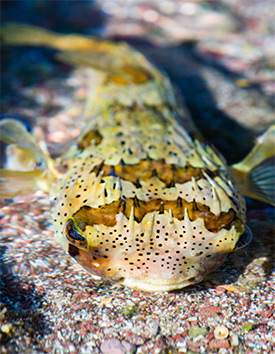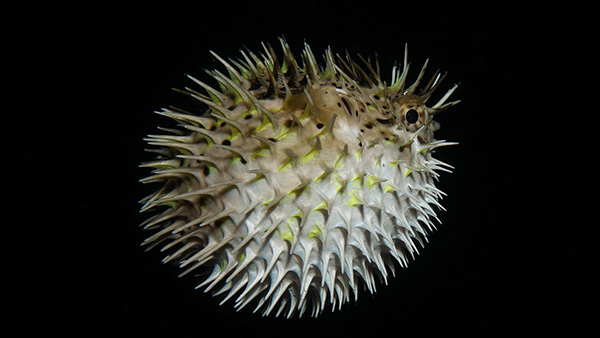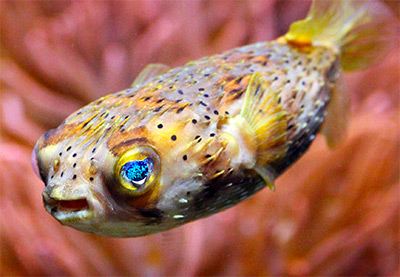Circumtropical in distribution and ascribed more common names than one can possibly keep straight (spiny puffer, porcupine puffer, porcupinefish, longspined porcupinefish, and balloon porcupinefish, to list but a few), Diodon holocanthus can be a worthy, very pet-like aquarium candidate. This species does, however, have certain non-negotiable needs to be met if it is to live a long, healthy life in captivity.
Physical traits
D. holocanthus has a robust, vaguely (American-style) football-shaped body with prominent, bulbous eyes and numerous elongated spines covering its body. These spines normally lie flat against the fish, but when threatened or harassed, it can swallow water or air, causing its body to inflate to nearly twice its size and its spines to stand erect (thus resembling what everyone else in the world calls a football with spikes all over it). The teeth are fused together to form a beak-like structure. Not the most colorful fish in the sea, D. holocanthus typically has a creamy to light-brown base color with dark-brown mottling and spots. Maximum size is upwards of 2 feet.
Feeding

This is where we get to the first of those non-negotiable care requirements. This puffer’s beak-like teeth are designed for crushing hard-shelled prey, and they grow continuously. If not worn down by hard food items, they will grow to the point that the puffer can no longer eat. So, it’s imperative to offer in-the-shell meaty foods—shrimp, clams, mussels, crabs, etc.—on a routine basis. Otherwise, you’ll eventually have to perform a little amateur dentistry on your puffer to keep them trimmed.
Also note that this species will constantly “beg” for food in almost puppy-like fashion. This doesn’t necessarily mean the specimen is genuinely hungry. It has simply learned to associate your presence with the arrival of food. Don’t be duped into overfeeding!
Housing
Another non-negotiable requirement for this species, in my opinion, is a very large tank. I’ve seen recommendations for minimum housing as low as 75 gallons, but this just doesn’t make sense to me. D. holocanthus may be a relatively slow swimmer, but it still gets very large, is a messy eater, and produces a lot of waste. I would put minimum housing for this fish closer to twice that recommended size—at least around 150 gallons.
A larger tank will also allow for some creative aquascaping to provide this fish, which tends toward the nocturnal, lots of places (ledges, caves) to hide as well as open swimming space.

Compatibility
Yet another non-negotiable requirement for D. holocanthus is to choose its tankmates with considerable discretion. Slower moving and/or long-finned species may be subject to nipping, and small fish may get eaten. So any piscine tankmates must be big relatively big and boisterous, such as larger angels, tangs, triggers, and wrasses. In some ways, D. holocanthus is better suited to be the star of a single specimen tank.
This puffer is definitely not a good candidate for reef systems, as it is likely to “sample” sessile invertebrates, will consume crustaceans and mollusks, and can really wreak havoc on water quality through its diet and waste production.



